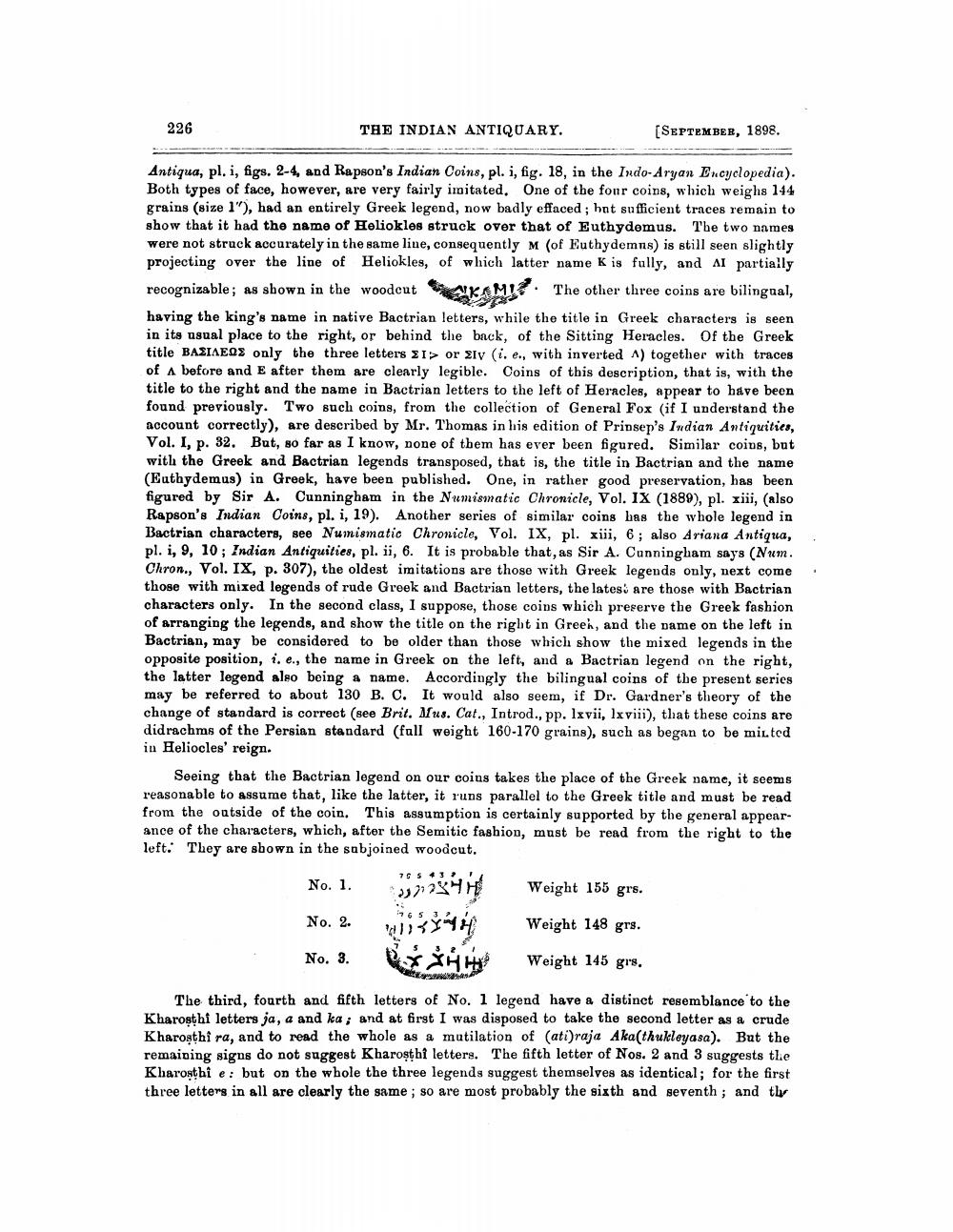________________
226
THE INDIAN ANTIQUARY.
[SEPTEMBER, 1898.
Antiqua, pl. i, figs. 2-4, and Rapson's Indian Coins, pl. i, fig. 18, in the Indo-Aryan Encyclopedia). Both types of face, however, are very fairly imitated. One of the four coins, which weighs 144 grains (size 1"), had an entirely Greek legend, now badly effaced; hot sufficient traces remain to show that it had the name of Heliokles struck over that of Euthydomus. The two names were not struck accurately in the same line, consequently m (of Euthydemns) is still seen slightly projecting over the line of Heliokles, of which latter name K is fully, and Al partially recognizable; as shown in the woodcut SAIKAMI. The other three coins are bilingual, having the king's name in native Bactrian letters, while the title in Greek characters is seen in its usual place to the right, or behind the back, of the Sitting Heracles. Of the Greek title BABIAEOX only the three letters XI> or Ely (i.e., with inverted A) together with traces of A before and E after them are clearly legible. Coins of this description, that is, with the title to the right and the name in Bactrian letters to the left of Heracles, appear to have been found previously. Two such coins, from the collection of General Fox (if I understand the account correctly), are described by Mr. Thomas in his edition of Prinsep's Indian Antiquities, Vol. I, p. 32. But, so far as I know, none of them has ever been figured. Similar coins, but with the Greek and Bactrian legends transposed, that is, the title in Bactrian and the name (Euthydemus) in Greek, have been published. One, in rather good preservation, has been figured by Sir A. Cunningham in the Numismatic Chronicle, Vol. IX (1889), pl. xiii, (also Rapson's Indian Coins, pl. i, 19). Another series of similar coins has the whole legend in Bactrian characters, see Numismatic Chronicle, Vol. IX, pl. xii, 6; also Ariana Antiqua, pl. i, 9, 10; Indian Antiquities, pl. ii, 6. It is probable that, as Sir A. Cunningham says (Num. Chron., Vol. IX, p. 307), the oldest imitations are those with Greek legends only, next come those with mixed legends of rude Greek and Bactrian letters, the lates) are those with Bactrian characters only. In the second class, I suppose, those coins which preserve the Greek fashion of arranging the legends, and show the title on the right in Green, and the name on the left in Bactrian, may be considered to be older than those which show the mixed legends in the opposite position, i.e., the name in Greek on the left, and a Bactrian legend on the right, the latter legend also being a name. Accordingly the bilingual coins of the present series may be referred to about 130 B. C. It would also seem, if Dr. Gardner's theory of the change of standard is correct (see Brit. Mus. Cat., Introd., pp. lxvii, Ixviii), that these coins are didrachms of the Persian standard (full weight 160-170 grains), such as began to be milted in Heliocles' reign.
Seeing that the Bactrian legend on our coins takes the place of the Greek name, it seems reasonable to assume that, like the latter, it runs parallel to the Greek title and must be read from the outside of the coin. This assumption is certainly supported by the general appearance of the characters, which, after the Semitic fashion, must be read from the right to the left. They are shown in the subjoined woodcut.
15 S3 No. 1.
2294H Weight 155 grs.
Weight 148 grs.
No. 3.
Weight 145 grs.
The third, fourth and fifth letters of No. 1 legend have a distinct resemblance to the Kharosthi letters ja, a and ka; and at first I was disposed to take the second letter as a crude Kharosthi ra, and to read the whole as a mutilation of (ati)raja Akathukleyasa). But the remaining signs do not suggest Kharosthi letters. The fifth letter of Nos. 2 and 3 suggests the Kharosthi e: but on the whole the three legends suggest themselves as identical; for the first three letters in all are clearly the same; so are most probably the sixth and seventh ; and the




